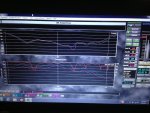Re: Aux feed subs?
I prefer it that way, you get vocal clarity even when you are absolutely trashing the instruments PA, you can optimize the vocal PA for vocals, and you get a more open sound with the vocals sitting in their own part of the three-dimensional aural space, much more like "real" acoustic sound untouched by bits and volts.
Years ago I changed from Aux subs to dual PA for larger shows. One PA is full range including subs tuned for instruments (read flat or neutral) and is taken from my main LR out. The other PA is just top boxes tuned for vocals and is taken from the highest sub-master or 2. Any delays or secondary feeds are from a matrix mixer. I find this leads to a nice sound with lots of head room, simplified wiring, and an easy to mix on system for “brother of the drummer is our sound guy” who have no clue about aux subs and other such magical audio things.
I prefer it that way, you get vocal clarity even when you are absolutely trashing the instruments PA, you can optimize the vocal PA for vocals, and you get a more open sound with the vocals sitting in their own part of the three-dimensional aural space, much more like "real" acoustic sound untouched by bits and volts.



